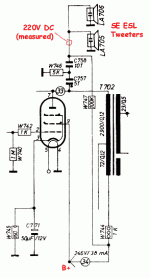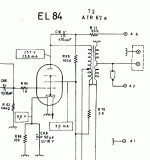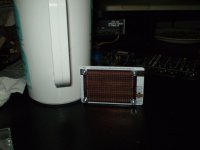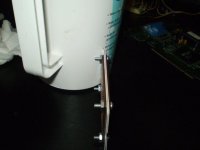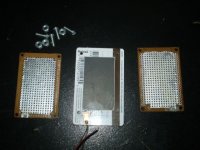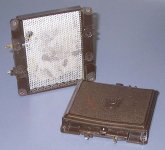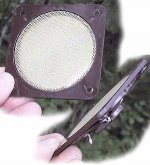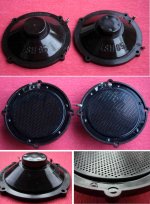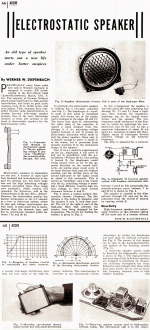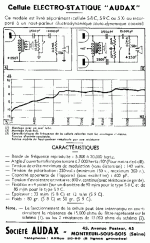I am looking at building speakers with electrostatic tweeters and I like these I found on ebay.
PAIR 3" LOEWE OPTA ELECTRO STATIC TWEETERS from Germany
vintage PAIR 3" LOEWE OPTA ELECTRO STATIC TWEETERS from germany | eBay
However I don't know anything about these speakers and there is no information in the listing.
Does anyone know what the voltage on the stators would be? I am also looking to use field coil woofers with these (Philcos) which use a voltage around 100VDC. What are the chances that I could use the field coil voltage on the stators?
PAIR 3" LOEWE OPTA ELECTRO STATIC TWEETERS from Germany
vintage PAIR 3" LOEWE OPTA ELECTRO STATIC TWEETERS from germany | eBay
However I don't know anything about these speakers and there is no information in the listing.
Does anyone know what the voltage on the stators would be? I am also looking to use field coil woofers with these (Philcos) which use a voltage around 100VDC. What are the chances that I could use the field coil voltage on the stators?
These tweeters are from the 50s, they aren't well documented and often confused (or intentionally mislabeled) with crystal tweeters (piezo). These piezo tweeters were called "ferroelektrischer Lautsprecher".
The electrostatic tweeters in these radios are very limited in the frequency range, starting at ~7kHz and dropping off at 12-15k, so it's probably not what you are imagine them to be. They are very limited in excursion, the distortion rises very quickly.
The best way to find informations about them is by looking at the 3 way Loewe radio schematics instead searching for the tweeters itself, Antique Radios, 322 557 Antique Radios listed is probably the best point to start. MAYBE there are also 2-way models with an electrostatic tweeter but I doubt it.
The electrostatic tweeters in these radios are very limited in the frequency range, starting at ~7kHz and dropping off at 12-15k, so it's probably not what you are imagine them to be. They are very limited in excursion, the distortion rises very quickly.
The best way to find informations about them is by looking at the 3 way Loewe radio schematics instead searching for the tweeters itself, Antique Radios, 322 557 Antique Radios listed is probably the best point to start. MAYBE there are also 2-way models with an electrostatic tweeter but I doubt it.
There were quite a few makers of those kind of SE ESL tweeters.
It would take a while to dig out, but go search for these, there is another thread where i posted examples of these kinds of tweteers and at least one sample schematic.
Isophon, Grundig, Lowe-optra, Blaupunkt
dave
It would take a while to dig out, but go search for these, there is another thread where i posted examples of these kinds of tweteers and at least one sample schematic.
Isophon, Grundig, Lowe-optra, Blaupunkt
dave
Attachments
You can DIY a set of these out of materials most people just throw away !! 
Not any different design than my Micro ESL driver made out of some PCB's and old credit cards.
Only you may need a slightly higher D/S (for Xmax) as this one one was made with a < .030" (30mil "D/S") spacing to the diaphragm
Single Stator Electrostatic Headphone - issues?
jer
Not any different design than my Micro ESL driver made out of some PCB's and old credit cards.
Only you may need a slightly higher D/S (for Xmax) as this one one was made with a < .030" (30mil "D/S") spacing to the diaphragm
Single Stator Electrostatic Headphone - issues?
jer
Attachments
[...] Blaupunct [...]
The brand name is Blaupunkt. I don't mind the spelling but the one letter might save wasted time on a search.
The documentation with just scanned catalogue pages as pictures makes searches often quite difficult, the picture descriptions are often vague at best. I don't know any Grundig radios which got an electrostatic tweeter, I'm not an expert on these old radios though - but I know they didn't use Loewe drivers, they used (AFAIK) exclusively their own drivers.
If you just need to know about the Loewe electrostatic ones because of the auction, narrow the search down to Loewe 3-way radio models. You can also narrow it down by the model years, ESL tweeters were mainly used from the 50s to the start-mid of the 60s because the new upcoming transistor circuits couldn't provide the required high voltage for the tweeters as easily (if at all) as the tube amps, which could conviniently provide this as a by-product of the tube principle circuits.
You can DIY a set of these out of materials most people just throw away !!
Not any different design than my Micro ESL driver made out of some PCB's and old credit cards.
I'm always amazed how much you can achieve with 'trash', you just need to realize the usage of it and improvise or search and apply knowledge and experience of others. I haven't read your posts about your ESL drivers yet but thanks for posting, I'll definitely read it!
Only you may need a slightly higher D/S (for Xmax) as this one one was made with a < .030" (30mil "D/S") spacing to the diaphragm
Yes, that's the main reason for the rapidly increasing distortion! The extremely low excursion, missing 'suspension' and asymmety of the single ended driver motors are the reason for the very quickly rising distortion and high crossover point.
The limited bandwidth is caused by problems of producing a very even kept thin thickness of the film sheet and mounting it and ofcourse the lack of bandwidth of the program material. Records and radio were quite limited in the frequency- and dynamic-range back then, there was no reason to aim for a higher upper frequency because hardly (or any) content got any usable information in it. Rather the opposite, a too high upper frequency range was frowned upon because it emphased the noise rather than improve the quality of the music reproduction.
Sorry, i was going to go check the spelling (right on the picture) but forgot, fixed now.
Don't worry, that happens, especially in a foreign language, happened to me too. Thanks for the edit. And I didn't know the Audax ESLs, thanks for posting! The foam on the back hints they need an open cabinet or a back chamber, they are probably the most promising tweeters for an own project because you've got a lot more possibilities to modify/use them.
The LSH85 are easily and often confused with cone tweeters because the back coil looks just as a magnet of a voice coil cone tweeter. The coil was mainly used to counteract the capacitor-like impedance drop to higher frequencies. The cone shaped back chamber of these tweeters of different brands was usually dampened to reduce the back chamber reflections/resonances. The eBay offer for the Loewe ESL is very flat, the resonances are that high you can't hear them but they got a high Q, very long decay and can cause the amp to oscillate. While Loewe got a lot of very good range of products, I'd choose a different ESL tweeters though.
I forgot to mention, if the back chamber is dampened, it's most of the times by felt which is the ideal situation because that's very stable over decades and does not change its properties very much. However, if the back chamber damping is realized by foam, it decomposed over time to either crumbs (the better variant) or to slimy, sticky gunk which is very hard to remove and renders the tweeter to a complete loss.
- Home
- Loudspeakers
- Planars & Exotics
- LOEWE OPTA Electrostatic tweeters
